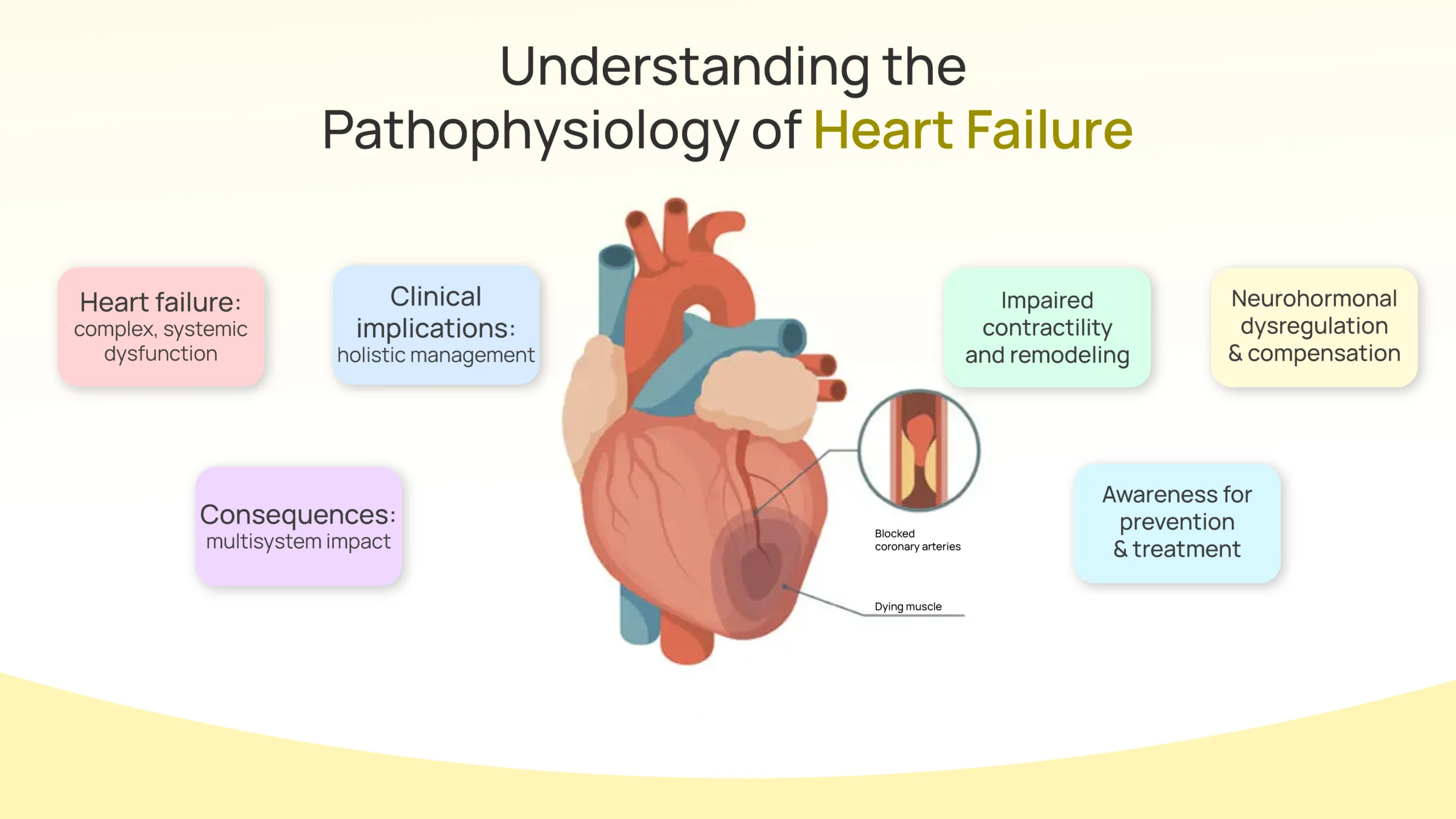
Author:- Mr. Ritesh Sharma
There are many people navigating the challenges of heart failure. Apart from this, clinicians are also learning every day about this life-threatening condition. Therefore, in this scenario, understanding the pathophysiology of heart failure becomes paramount. Heart failure on the surface might seem like just the cessation of the heart’s function. However, it is much more complex than that. It involves the interplay of physiological malfunctions that undermine the heart’s ability to effectively pump blood throughout the body.
A lot of people globally are affected by this condition and unfortunately for most people, it turns out to be fatal. While learning the pathophysiology of heart failure won’t completely mitigate its risk, it will surely give us more insights into this hazardous condition and help healthcare professionals opt for the correct treatment options for patients.
In this block, we will delve deep into the intricacies that form the pathophysiology of heart failure. For this, we will discuss the definition of heart failure, the role of the heart, the consequences, clinical implications, and more. So, all individuals who want to learn about the pathophysiology of heart failure will be educated and empowered by this blog.
What is heart failure?
First off, it is necessary to understand the proper meaning of heart failure. For this, we would like to make it clear that it is vastly different from heart attacks and cardiac arrest. At its core, heart failure refers to the heart’s inability to pump blood efficiently to meet the body’s demands. This can occur due to a variety of underlying causes, including coronary artery disease, hypertension, valvular heart disease in which valves cannot prevent the backflow of blood to the heart, and myocardial infarction, among others. Regardless of the initial trigger, the pathophysiology of heart failure typically involves a string of events that culminate in compromised cardiac function.
The Role of the Heart
To completely understand the pathophysiology of heart failure, one needs to understand the actual role of the human heart in the body. The heart operates as a muscular pump, comprising four chambers: two atria and two ventricles. Blood flows into the right atrium from the body and is then pumped into the right ventricle. It also contains a septum which prevents the mixing of oxygenated and deoxygenated blood.
From the ventricles, the blood is pushed into the lungs to collect oxygen. Oxygenated blood returns to the left atrium and is pumped into the left ventricle, which propels it out to the rest of the body. This rhythmic cycle ensures a continuous supply of oxygen and nutrients to tissues and organs.
Pathophysiology of Heart Failure
Now, let’s dive deep into the pathophysiology of heart failure- as we have understood the role of the heart, it is now relatively easy to study its pathophysiology. The heart disrupts the intricate process of circulation through several mechanisms. One primary mechanism involves impaired contractility, where the heart muscle becomes weakened and unable to generate sufficient force to pump blood effectively. This may result from damage to the myocardium, as seen in myocardial infarction, or from chronic conditions like hypertension, which overburden the heart over time.
Another key aspect is altered ventricular remodeling. In response to stressors such as increased blood pressure or volume overload, the heart undergoes structural changes aimed at compensating for its diminished function. However, these adaptations often exacerbate the problem, leading to further deterioration of cardiac performance. For instance, the heart may enlarge (ventricular dilation) or thicken (ventricular hypertrophy), ultimately compromising its ability to contract and relax efficiently.
Furthermore, neurohormonal dysregulation plays a pivotal role in heart failure progression. The body’s natural response to reduced cardiac output is to activate compensatory mechanisms, such as the sympathetic nervous system and the renin-angiotensin-aldosterone system (RAAS), to maintain blood pressure and perfusion. While initially beneficial, prolonged activation of these pathways can have deleterious effects, including increased heart rate causing heart palpitations and cardiac arrhythmias of different arrhythmia classifications such as tachycardia, vasoconstriction, fluid retention, and cardiac remodeling such as ventricular remodeling.
The Consequences of heart failure
The consequences of heart failure extend beyond the cardiovascular system, impacting virtually every organ and tissue in the body. Reduced cardiac output leads to inadequate tissue perfusion, resulting in symptoms such as fatigue, dyspnea, and exercise intolerance. Fluid retention, a hallmark of heart failure, contributes to pulmonary congestion (leading to dyspnea) and peripheral edema, further impairing quality of life.
Moreover, the kidneys, in their attempt to compensate for decreased cardiac output, retain sodium and water, exacerbating fluid overload and contributing to the vicious cycle of heart failure progression. Liver congestion, gastrointestinal disturbances, and neurocognitive impairments are also common manifestations of advanced heart failure, underscoring its systemic nature.
Clinical Implications of Heart Failure
There are numerous clinical implications of heart failure. To understand them, it is important to understand the pathophysiology of heart failure. Therapeutic interventions aim to reduce symptoms, improve quality of life, and reduce morbidity and mortality. Pharmacological agents such as angiotensin-converting enzyme (ACE) inhibitors, beta-blockers, diuretics, and mineralocorticoid receptor antagonists target key pathways involved in heart failure progression, helping to mitigate its deleterious effects.
In addition to pharmacotherapy, lifestyle modifications, including dietary changes, regular exercise, and smoking cessation, play a crucial role in managing heart failure. Patient education and self-care strategies empower individuals to actively participate in their treatment and minimize disease exacerbations.
In conclusion, it is important to understand the pathophysiology of heart failure of patients and healthcare professionals alike. Moreover, raising awareness about the pathophysiology of heart failure is essential for fostering a deeper understanding among patients, caregivers, and the general public, ultimately paving the way for better prevention, management, and treatment of this prevalent and burdensome disease.




